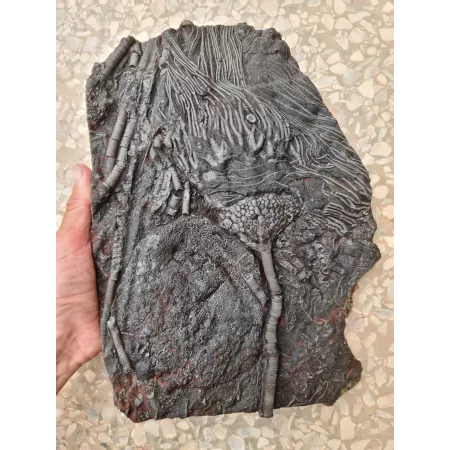Discover the Fascinating Crinoids | Evolutionary Marvels Over 500 Million Years

Crinoid
About Fossil Crinoids
Fossil crinoids, also known as "sea lilies," are marine animals that thrived millions of years ago, primarily during the Paleozoic Era.
Structure and Appearance
Fossil crinoids come in various forms, but many have a plant-like appearance. They consist of a calcareous stem or "column" attached to the seafloor, from which radiate branched arms. These arms were used to capture food particles from the water.
Size
Fossil crinoids could vary greatly in size, ranging from a few centimeters to several meters in length for some species.
Location
Crinoids were abundant in ancient seas, primarily inhabiting shallow waters. Their fossilized remains are often found in sedimentary rocks formed from marine deposits.
Composition
The most commonly fossilized parts of crinoids are their calcareous ossicles, which formed the stem and arms. These structures are often well-preserved in fossiliferous rocks.
Lifestyle
Crinoids were typically sessile organisms, attached to the seafloor by their column. Some were mobile during their juvenile stage, but many adult crinoids remained fixed in one spot throughout their lives.
Evolution
Crinoids have a long evolutionary history...
Crinoid
Crinoids have an incredible evolutionary history, dating back over 500 million years. While they underwent many changes over time, some basic features of their anatomy remained relatively unchanged, allowing paleontologists to trace their evolution through geological ages.
These fascinating marine creatures, also known as sea lilies, are part of the phylum Echinodermata and belong to the class Crinoidea. Their delicate and intricate structures have captivated researchers and enthusiasts alike, offering insights into the ancient underwater ecosystems and the processes of evolution.
Crinoids exhibit a unique combination of radial symmetry and pentaradial symmetry, making them stand out among other marine organisms. Their distinctive feeding apparatus, composed of tube feet and a filter-feeding system, showcases their specialized adaptations for life in marine environments.
The diverse forms and adaptations of crinoids have led to a rich fossil record, contributing significantly to our understanding of prehistoric seas and the evolution of life on Earth. From shallow tropical waters to deep-sea habitats, crinoids have thrived in various marine ecosystems, leaving behind a legacy of incredible diversity and resilience.
